Nevada is fortunate in that it has over a dozen species of woodpeckers, sapsuckers, and flickers that visit or make the state their home. That’s more than almost any other state in the US!
From the common and brave downy woodpecker to the rare and shy black-backed woodpecker, there are lots of these unique and unusual birds hanging out in the Silver State.
Of course, you’re more likely to see some of these birds if you head out to places like Henderson Bird Viewing Preserve or Great Basin National Park, but don’t feel like you need to travel far to work on your Life List.
Many of the woodpeckers on this list will come and visit suet feeders or will even make their nests in home roofs or siding. Just listen for that tell-tale pecking and keep a good eye out.
Here is the list of species of woodpeckers in Nevada:
- Downy Woodpecker
- Acorn Woodpecker
- Hairy Woodpecker
- White-Headed Woodpecker
- Red-Breasted Sapsucker
- Lewis’s Woodpecker
- Williamson’s Sapsucker
- Red-Naped Sapsucker
- American Three-Toed Woodpecker
- Pileated Woodpecker
- Ladder-backed Woodpecker
- Northern Flicker
- Black-Backed Woodpecker
- Nutall’s Woodpecker
14 Types of Woodpeckers in Nevada
1. Downy Woodpecker

- Scientific name: Dryobates pubescens
- Size: 7 inches long
- Weight: 0.75-0.99 ounces
- Wingspan: 10-12 inches
The downy woodpecker is the smallest woodpecker that you can find in Nevada (and much of the rest of the US). But don’t worry, its tiny size doesn’t make it difficult to spot. That’s because it’s bold and not too afraid of people. It’s probably the most common woodpecker to see in all of Nevada, so the chances are good that you’ll be able to spot one.
This cute little bird doesn’t migrate. Instead, it stays in its home year-round, which means you can spot these woodpeckers anytime you head outside. While they may change their habitat range during the seasons, they don’t travel too far. The only place where they don’t live in Nevada is the southern tip in the Las Vegas region.
Hang a suet feeder in your yard if you want to be able to see these birds. They’re the most frequent visitor of suet feeders of all the different woodpeckers in Nevada. They also love deadwood, which means that you can spot them in the many recently burned forests in the state.
You can find this small woodpecker pretty much anywhere. It lives in rural areas, cities, suburban yards, and wilderness areas.
During the wintertime, they flock with other birds such as chickadees and nuthatches for safety and to find food. They build their nests in the cavity of trees where they live and raise their young. Their nests can be extremely high up in trees.
Downy woodpeckers are black and white, with distinctly spotted wings and a white chest. Adult males have a bright red cap on the back of their heads, which makes them easy to identify from females.
Because of their small size, they can land on small stems of plants to hunt for food. They’re also small enough that they often make nests in the wood siding of homes, much to the dismay of homeowners.
2. Acorn Woodpecker

- Scientific name: Melanerpes formicivorus
- Size: 7.5-9 inches
- Weight: 2.3-3.2 ounces
- Wingspan: 14-17 inches
Acorn woodpeckers are often described as having the face of a clown because they have a black mouth surrounded by a white border and black over their eyes. They have a red cap, a black body, and a white patch on the rear and on each wing. The chest is slightly gray or white.
These birds live in evergreen forests on the west coast and in a few parts of the southwest. These birds collect acorns and fill holes in trees full of the collected nuts. These caches of nuts can be used by generations of woodpeckers, and one tree may contain up to 50,000 holes. They’ll also make nests in one of the holes that they create.
In addition to acorns, they also eat insects, especially ants, as well as seeds, nuts, and sometimes the eggs of other birds.
This is one of the few species that prefers to live in small colonies rather than alone, and studies reveal that they do this to help one another raise young, a practice called cooperative breeding.
Acorn woodpeckers are rare visitors to Nevada. They’ve only been spotted in the far western part of the state along the California border. Still, if you live in the area or you’re visiting, you might be able to add them to your Life List!
3. Hairy Woodpecker

- Scientific name: Picoides villosus
- Size: 7.5 inches
- Weight: 1.4-3.4 ounces
- Wingspan: 13-16 inches
Hairy woodpeckers look similar to downy woodpeckers, but they’re much larger. They also have longer bills, which are almost the same length as their head. They’re black and white, and you can tell the genders from one another because the adult males have a little red spot on the back of their heads.
These pretty woodpeckers aren’t as common in Nevada as their cousin, the downy woodpecker, but they’re still pretty easy to find. You can see them in parks, suburban areas, cemeteries, and other quiet wooded or open areas. They also visit suet feeders in suburban backyards. They don’t live in the most southern part of the state, however.
Like their cousin, the downy woodpecker, hairy woodpeckers don’t migrate during the cold weather and stay in the same place all year. They make their homes in the cavities of dead trees.
Research published in The Journal of Wildlife Management found that they prefer forests that have been recently burned because there is abundant food for them there. Since Nevada has had many wildfires in the past few years, they can be easier to spot in those areas rather than in cities.
Populations have been declining in the past decades because they’re losing their habitat. They also face pressure from invasive birds like European starlings, which steal their nesting spots.
4. Red-Breasted Sapsucker
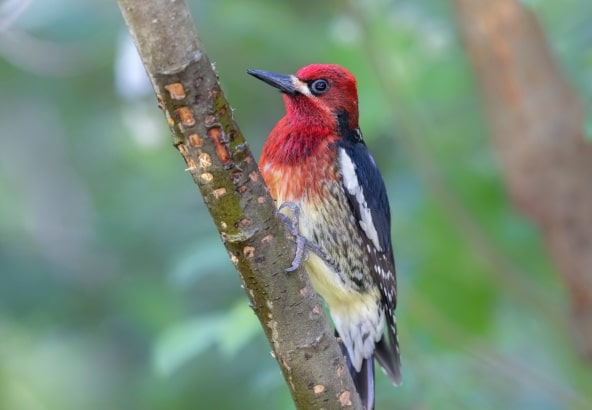
- Scientific name: Sphyrapicus ruber
- Size: 7.9-8.7 inches
- Weight: 1.9-2.2 ounces
- Wingspan: 14.5-16 inches
These woodpeckers live on the west coast of the US, migrating from Canada to parts of Northern California in the winter. In Nevada, they live in the western corner of the state during the winter.
They have brush-like tongues that they use to lap up sap that they access by pecking little holes in the wood of trees. They’ll also eat the soft green layer of wood underneath the bark. They also eat berries and fruit and will visit suet feeders.
The adults have a red head and chest, with a black back and mottled grey and black chest. Juveniles lack the red head and chest and have an overall brown hue.
They’re related to Red-naped sapsuckers, and for a while, scientists thought they were the same species. Scientists have determined that these birds prefer old-growth forests and that populations might be reduced as old-growth forests are cut down.
5. Lewis’s Woodpecker

- Scientific name: Melanerpes lewis
- Size: 10.2-11 inches
- Weight: 3.1-4.9 ounces
- Wingspan: 19-.20.5 inches
This medium-sized bird lives across the western half of the US, migrating from the northern part of the country to the southern region during the winter.
Named for Lewis Merryweather of Lewis and Clark fame, this woodpecker hangs out in the northern part of Nevada during the breeding season, migrates through the central areas, and lives in the southern part of the state during the non-breeding season.
They don’t dig or peck into the wood but find insects crawling around on the bark.
These pretty woodpeckers are green and pink with a red face and white neck, which makes them stand out among other species. It also likes to catch insects mid-air while they’re flying, which sets it apart from other birds. That’s something most woodpeckers don’t do, for the most part.
As fall comes around, this industrious bird collects acorns and other nuts and stuffs them into cavities in trees so that they have food for later.
Pairs mate for life and make nests in excavated trees or utility poles.
6. Williamson’s Sapsucker

- Scientific name: Sphyrapicus thyroideus
- Size: 8.3-9.8 inches
- Weight: 1.6-1.9 ounces
- Wingspan: 17 inches
Like other sapsuckers, this one drills small holes into trees. Then they wait for the sap to start leaking out, and they drink it. They also eat ants and other small insects.
They prefer coniferous forests and live in western North America’s mountains. They spend their time in the higher elevation forests and drop down to lower elevations during the winter.
In the 1990s, scientists found that this sapsucker had extended its range as far south as Baja California, but they only live in a few small parts of central Nevada and only during their breeding season.
Large for a sapsucker, the males are mostly black with white patches on the wings and a red throat. The females have horizontal barring on their backs. They also have brown heads. The sexes appear so different from one another that scientists initially thought that they were different species.
The males carve out holes in the trees to create a nest for the female to lay her eggs in.
7. Red-Naped Sapsucker
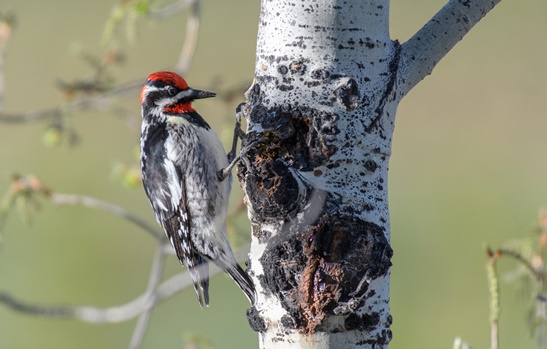
- Scientific name: Sphyrapicus nuchalis
- Size: 7.5-8.3
- Weight: 1.1-2.3 ounces
- Wingspan: 16-16.9 inches
As the name suggests, this bird has a thing for the sap in trees. It will tap little holes into the bark so that sugary sap runs out, and it can lap it up with its tiny tongue.
They particularly love aspen, pine, and birch trees. They’ll even nest in backyards that have those trees, so if you have these trees, keep an eye out for this bird. You can even increase the chance that they’ll visit or come to stay if you provide them with a suet feeder.
These sapsuckers have vertical white patches on their back that you can only see when the wing is folded. They have black and white striped bodies and heads and a bright red cap and throat, though some females have a white throat.
This is a close relative of the red-bellied sapsucker and the yellow-bellied sapsucker. They all look fairly similar.
Red-naped sapsuckers live in the northeast part of the state during the breeding season and migrate through the rest. There is a small corner in the southern part of Nevada where you can find these woodpeckers during the winter, as well.
8. American Three-Toed Woodpecker
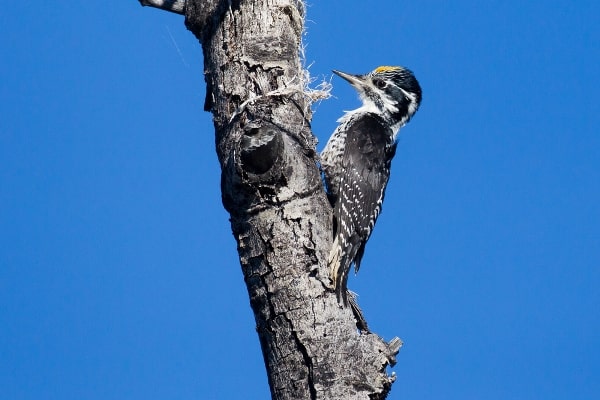
- Scientific name: Picoides dorsalis
- Size: 8.3-9.1 inches
- Weight: 1.6-2.4 ounces
- Wingspan: 14.6-15.3 inches
This woodpecker primarily makes Canada its home, but it also lives year-round in western parts of the country, including Nevada, Nevada, Colorado, and Wyoming. You’ll have to look hard, though. They only live in the eastern edge of the state in the Wendover area.
This bird likes to hunt in burned-out areas and forests where beetles have killed lots of trees. It hunts for insects, pulling and stripping away bark until it finds what it is looking for.
Yes, this bird only has three toes, but you’ll most easily be able to identify it by its coloring. It’s primarily black, but it does have white barring on its sides and back, and the chest is white. The male has a bright yellow crown.
If you see these woodpeckers in your Nevada yard, welcome them! They eat destructive beetles that can kill trees.
9. Pileated Woodpecker

- Scientific name: Dryocopus pileatus
- Size: 16-19 inches
- Weight: 9-14 ounces
- Wingspan: 30 inches
The pileated woodpecker only rarely visits the very northwestern edge of Nevada. They often make their nests in utility poles or high up in tall trees in deadwood. Their favorite snack is carpenter ants, which they will dig rectangular holes deep into the wood to find.
They’ll also eat nuts and berries and have even been known to chomp on poison ivy berries. You may occasionally see them foraging on the ground for food, but they usually stick to the trees.
These striking birds are mostly black and white, but they are very distinct because of their bright red crest. The males also have a red stripe on the side of their faces. These are larger birds, about the same size as a crow.
The pileated woodpecker doesn’t migrate. It stays in the same area year after year. They will, however, move their nest if the eggs fall out of it.
The cartoon bird Woody Woodpecker was likely based on this species.
10. Ladder-Backed Woodpecker
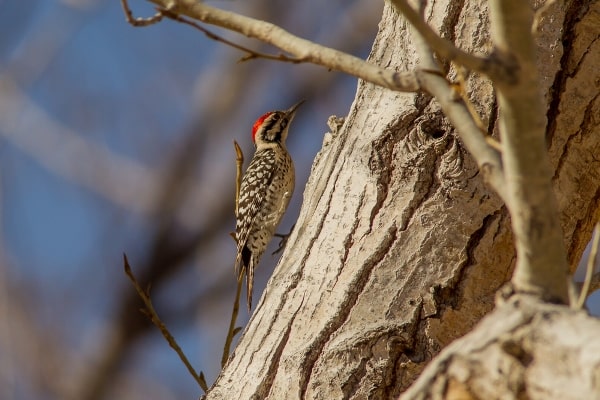
- Scientific name: Dryobates scalaris
- Size: 6.3-7.1 inches
- Weight: 0.7-1.7 ounces
- Wingspan: 13 inches
Across the arid desert of the southwestern US live the Ladder-backed woodpecker. These tiny foragers flit among the cacti to find food, and they’ll also visit feeders that have mealworms or black oil sunflower seeds.
They’re black and white with white bars across the wings and back that look very much like a ladder. The chest is spotted black and white. The males have a red crown.
While other woodpecker species that make their home in the desert need large plants to make a nest in, these petite little birds can live in the scrub and shrubs. They’re a close relative of the Nutall’s woodpecker.
You can only spot them in the very southwest part of the state near Las Vegas and other nearby areas, but they live there year-round.
11. White-Headed Woodpecker

- Scientific name: Dryobates albolarvatus
- Size: 8.3-9.1 inches
- Weight: 1.9-2.3 ounces
- Wingspan: 16-17 inches
These unusual woodpeckers only live on the very western border of Nevada. They eat pine nuts as well as insects that they find under the bark of the tree. They don’t typically peck holes into wood as other woodpeckers do. Instead, they peel and pull off the bark of trees to look for bugs hiding underneath.
They are black with a white head and white patches on the undersides of the wins. The males have red caps. They’re the only woodpecker in North America with a solid black body and solid white head, which makes them easy to identify.
They typically choose to flock in pairs or in small groups made up of related birds.
12. Northern Flicker

- Scientific name: Colaptes auratus
- Size: 11-12 inches
- Weight: 4-6.5 ounces
- Wingspan: 16.5-20 inches
The distinctive Northern Flicker woodpecker lives in open habitats near trees, as well as in parks and cemeteries across Nevada. They are a frequent visitor to suet feeders in suburban and urban yards. Unlike some woodpeckers, they like to hunt around on the ground rather than in the trees.
They’re another one of the most common woodpeckers in Nevada, but they don’t all look the same, which can make identifying them a challenge.
The males, females, and juveniles vary in appearance depending on where they live. They’re brown in color overall, with black spots. The underside of the wings and tails are yellow in the eastern half of the US and red in the western half of the US. Some have a red or black stripe on their cheeks, and many of them have large, black crescents on their chest. Others have red marks on the back of the head. Some have a slightly gray head. Confusing, right?
In Nevada, these woodpeckers can be identified by their salmon wings on the undersides and red stripes on their cheeks.
In the spring, you can hear the calls of Northern flickers for a long way off. They have a distinct call, and once you know what it sounds like, it’s easy to tell when they’re nearby.
They primarily eat ants, but they’ll also dine on other insects such as caterpillars, beetles, and termites. They’re definitely a bird you want to have around! There are also instances of them catching young bats as they leave the nest. You can tempt them to visit your home by offering a suet feeder in the yard.
Flickers who live in northern climates like Alaska and Canada will migrate to places with warmer temperatures during the winter. Northern Flickers stay put in Nevada year-round.
Studies show that Northern Flickers can lose their nests to invaders like European starlings. Plus, many humans are trying to deter them because they can make holes in the wood and cavities of homes.
13. Black-backed Woodpecker

- Scientific name: Picoides arcticus
- Size: 9.1 inches
- Weight: 2.1-3.1 ounces
- Wingspan: 15.8-16.5 inches
Many woodpeckers in North America are some pattern of black and white, often with a red patch on the head. This woodpecker stands out because of its solid black back and white chest. It has a black face with a distinct white stripe. The male has a small yellow crown.
Making its home in burned-out forests across Canada and the western US, its black coloring helps it blend in with the charred trees that it hunts on. It eats beetle larvae and will hang out in recently-burned areas for several years before moving onto more newly burned areas.
It’s a rare sight in Nevada and you’ll only be able to find it along the northwestern border.
14. Nutall’s Woodpecker
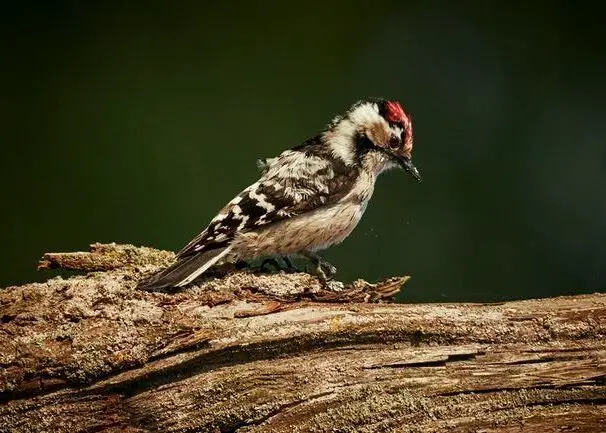
- Scientific name: Dryobates nuttallii
- Size: 6.3-7.1 inches
- Weight: 1.1-1.6 ounces
- Wingspan: 13-16 inches
Nutall’s woodpeckers only live in Southern California and Baja California in open woodlands with oaks, willows, and cottonwoods. Once in a while they will stray up to southern Oregon and western Nevada. Though it doesn’t have a large range, it’s common in the areas where it does live.
They’ve been known to visit suet feeders, though they’re much less common visitors than some other woodpeckers. When you’re looking for these birds, gaze up at tall oaks as you walk by and you might be lucky enough to see one.
The males tend to hang out on the trunk and larger branches to feed, while the females stick to smaller branches and twigs.
These diminutive woodpeckers are white and black, so they look similar to some of their related species. You can differentiate the males from the females by the bright red stripe on the back of the male’s heads. They have horizontal stripes on their back and two thin stripes on their cheeks. Juvenile birds have slightly gray feathers on their undersides.
Males excavate the nests in trees and the females lay their eggs. Pairs tend to be monogamous and stick together for years.
Also Read: Owls in Nevada
